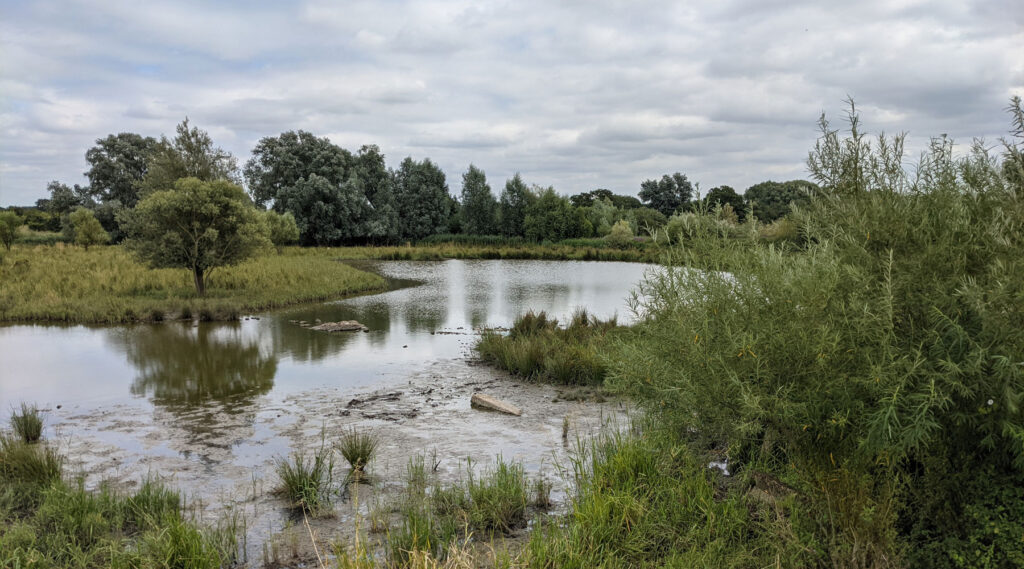A large public park in East London contains probably the richest collection of WW2 concrete fortifications still existing within London within one small area. This is a former military airfield that was landscaped into a country park for the locals in the 1980s, but retained a lot of heavy concrete fortifications to discover.
The airfield, RAF Hornchurch was opened during WW1, when it was known as Sutton’s Farm, for the protection of London, and although it closed after the war, it was reopened just a few years later as a much larger airfield for the RAF. The airfield was ideally to cover both London and the Thames corridor from German air attacks. It was a key air force installation between both wars and into the jet age, closing in 1962.
After it closed, most of the land was used for gravel extraction, and as a dump, until it was landscaped in the 1980s into Hornchurch Country Park, which is open to the public.
It’s a huge space, bordered on one side by the River Ingrebourne, and housing on the other, but within are good hills to climb, plenty of woodlands to wander around, and a lot of bits of WW2 military fortifications to explore.
Fortunately, there’s a walking trail if you’re here looking for WW2 concrete to explore, with a lot of pill boxes around the old military site to protect it if the Germans had invaded the country. What’s really nice is that the display boards close to them also show how large they are underground — as many are quite a lot larger than people might otherwise suspect. A few are large enough to walk inside, if you don’t mind risking the occasional spider’s web or dodgy graffiti inside.
The southern end is also higher, and there’s a good trig-point style stone pyramid at the summit of the hill that gives some good views across this part of East London and right over to central London. The hill is largely grasses, and it’s not until you get down into the valley that shade, and in places streams cool the air down.
The paths are a mix of gravel or tarmac, but in one place the paths aren’t from the country park clean-up in the 1980s, but are the airfield perimeter roads that would have been patrolled by armed soldiers during the war.
Depending on how you get here, there’s a visitor centre on the northern end of the park, or as I did, start at the southern end close to Rainham Hall. There’s a rather awkard-looking carving of a fighter plane next to the visitor centre at the northern end that looks less terrifying to the enemy than rather cuddly. And as you’re in the area, there’s the recently opened RAF Hornchurch museum, which is excellent.
As a country park, it’s a lovely place to wander around, although the southern half is more baren and on a hot day quite unforgiving with the lack of shade, but what makes it worth a visit from afar is the WW2 walking trail, as it’s got a lot to see as you walk along ticking off each concrete fortification as you find them.
It’s a short walk from either Rainham station on the C2C line, or Hornchurch station on the District line.
















Hills on an airfield? Are they original do you know, or are they full of rubbish and ‘landscaped’?
Hoveringhams dug sand pits over there and yes it was landfill afterwards.
These were protective revetments around fighter parking areas linked to taxiways ,
They were filled in and landscaped by the council , similiar ones are preserved at north Weald airfield incorporating air raid shelters in banks
It’s Hornchurch Essex not east London.
Hornchurch has been part of London since 1965.
Nope. I’ve lived in Elm Park (part of Hornchurch) all my life, and it is most definitely London. The London borough of Havering to be precise. London Fire Brigade, London Ambulance Service, Metrolitan (London) Police and best yet, I have a free over 60s oyster card. They don’t give those out in Essex.
There are plenty who like to claim it is Essex, but, it isn’t.
My father was one of hundreds of airmen who camped overnight at RAF Hornchucrh in May ’45 before catching a boat to Ostend; they were part of an RAF disarmament wing ordered to Germany to dismantle the Luftwaffe. As it happned the day his party crossed was the day the war in Europe ended via signature though they wouldn’t have known it at the time I think.
We thank your Father for everything he did for us, along with all the other men and women without whom we wouldn’t be here today. Certainly not speaking English anyway.
I attended both R.J.Mitchell school, named after the inventor of the Spitfire and Sanders Draper school, named after the American pilot who bravely sacrificed his life to save the children in the, then, Suttons School. So we used to walk home across the airfields and we once let ourselves down into an underground air raid hut through a hole in the roof. Goodness knows what we thought we were doing, or how we were going to get out again (there was a lot of unladylike scrabbling, I recall) but it was just a big part of our lives and local history.
My parents could remember when The Good Intent public house was closed off to all but officers from the airfield.
Took a visit this weekend prompted by your blog piece. Was a fun and interesting walk – thank you!